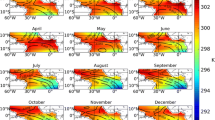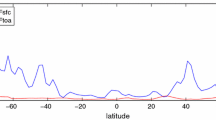Abstract
Poleward heat (energy) transport plays a major role in shaping the Earth’s climate. Its oceanic and atmospheric components carry heat from low to high latitudes thus reducing the equator-to-pole temperature contrast. In quasi-equilibrium climate states, changes in the top-of-the-atmosphere (TOA) energy fluxes and ocean heat content remain small. In such conditions, anomalies in oceanic and atmospheric heat transport must have the same magnitude but opposite signs. This phenomenon is known as the Bjerknes compensation (BJC). The BJC hypothesis is of high importance in climate, since it imposes a strong constraint on climate variability at sufficiently long timescales (on sub-decadal and shorter timescales TOA flux variations may become comparable to other heat budget terms, interfering with BJC). However, to which extent BJC operates in the climate system and the key mechanisms of the compensation remain poorly understood. Here we analyze BJC in the IPSL-CM6A-LR climate model, focusing on its timescale dependence, its links to the Atlantic Meridional Overturning Circulation (AMOC), and the connection to Intertropical Convergence Zone (ITCZ) shifts. We show that BJC occurs in the model at both multi-decadal and centennial timescales, but is stronger on centennial timescales than decadal. In both cases BJC is initiated by variations in ocean heat transport induced by AMOC variability that are partially or fully compensated by atmospheric heat transport. For decadal timescales, we find two regions of a strong BJC at latitudes associated with the storm track region and the marginal ice zone in the Northern Hemisphere. Finally, on centennial timescales we observe a Bjerknes-like interbasin compensation between the Atlantic and Indo-Pacific heat transports, which is also related to strong centennial AMOC fluctuations and involves Southern Ocean zonal heat transport.










Similar content being viewed by others
Data availability
The IPSL-CM6A-LR piControl data was retrieved from the Earth System Grid Federation (ESFG) web page (Boucher et al 2018). Observed ocean heat transport data is available in https://doi.org/10.5065/9v3y-fn61. The CERES_EBAF_Ed4.0 dataset was downloaded from https://ceres-tool.larc.nasa.gov.
References
Barnett TP, Pierce DW, Schnur R (2001) Detection of anthropogenic climate change in the world’s oceans. Science 292(5515):270–274. https://doi.org/10.1126/science.1058304
Barry L, Craig GC, Thuburn J (2002) Poleward heat transport by the atmospheric heat engine. Nature 415(6873):774–777. https://doi.org/10.1038/415774a
Bjerknes J (1964) Atlantic air-sea interaction. Adv Geophys 10:1–82. https://doi.org/10.1016/S0065-2687(08)60005-9
Bonnet R, Boucher O, Deshayes J, Gastineau G, Hourdin F, Mignot J, Servonnat J, Swingedouw D (2021) Presentation and evaluation of the IPSL-CM6A-LR Ensemble of extended historical simulations. J Adv Model Earth Syst 13(9): e2021MS002565. https://doi.org/10.1029/2021MS002565
Boucher O, Denvil S, Levavasseur G, Cozic A, Caubel A, Foujols M-A, Meurdesoif Y, Cadule P, Devilliers M, Ghattas J, Lebas N, Lurton T, Mellul L, Musat I, Mignot J, Cheruy F (2018) IPSL IPSL-CM6A-LR model output prepared for CMIP6 CMIP piControl. Earth System Grid Federation. https://doi.org/10.22033/ESGF/CMIP6.5251
Boucher O, Servonnat J, Albright AL, Aumont O, Balkanski Y, Bastrikov V, Bekki S, Bonnet R, Bony S, Bopp L, others (2020) Presentation and evaluation of the IPSL-CM6A-LR climate model. J Adv Model Earth Syst 12(7). https://doi.org/10.1029/2019MS002010
Dai H, Yang H, Yin J (2017) Roles of energy conservation and climate feedback in Bjerknes compensation: a coupled modeling study. Clim Dyn 49(5):1513–1529. https://doi.org/10.1007/s00382-016-3386-y
Donohoe A, Marshall J, Ferreira D, Mcgee D (2013) The relationship between ITCZ location and cross-equatorial atmospheric heat transport: From the seasonal cycle to the Last Glacial Maximum. J Clim 26(11):3597–3618. https://doi.org/10.1175/JCLI-D-12-00467.1
Farneti R, Vallis GK (2013) Meridional energy transport in the coupled atmosphere–ocean system: Compensation and partitioning. J Clim 26(18):7151–7166. https://doi.org/10.1175/JCLI-D-12-00133.1
Ferrari R, Ferreira D (2011) What processes drive the ocean heat transport? Ocean Model 38(3–4):171–186. https://doi.org/10.1016/j.ocemod.2011.02.013
Ferster BS, Fedorov AV, Mignot J, Guilyardi E (2021) Sensitivity of the Atlantic meridional overturning circulation and climate to tropical Indian Ocean warming. Clim Dyn 57(9):2433–2451. https://doi.org/10.1007/s00382-021-05813-w
Frierson DM, Hwang Y-T (2012) Extratropical influence on ITCZ shifts in slab ocean simulations of global warming. J Clim 25(2):720–733. https://doi.org/10.1175/JCLI-D-11-00116.1
Frierson DM, Hwang Y-T, Fučkar NS, Seager R, Kang SM, Donohoe A, Maroon EA, Liu X, Battisti DS (2013) Contribution of ocean overturning circulation to tropical rainfall peak in the Northern Hemisphere. Nat Geosci 6(11):940–944. https://doi.org/10.1038/NGEO1987
He C, Liu Z, Hu A (2019) The transient response of atmospheric and oceanic heat transports to anthropogenic warming. Nat Clim Change 9(3):222–226. https://doi.org/10.1038/s41558-018-0387-3
Held IM (2001) The partitioning of the poleward energy transport between the tropical ocean and atmosphere. J Atmos Sci 58(8):943–948. https://doi.org/10.1175/1520-0469(2001)058%3c0943:TPOTPE%3e2.0.CO;2
Hourdin F, Rio C, Grandpeix J-Y, Madeleine J-B, Cheruy F, Rochetin N, Jam A, Musat I, Idelkadi A, Fairhead L, others (2020) LMDZ6A: The atmospheric component of the IPSL climate model with improved and better tuned physics. J Adv Model Earth Syst 12(7): e2019MS001892. https://doi.org/10.1007/s00382-012-1343-y
Jackson L, Vellinga M (2013) Multidecadal to centennial variability of the AMOC: HadCM3 and a perturbed physics ensemble. J Clim 26(7):2390–2407. https://doi.org/10.1175/JCLI-D-11-00601.1
Jiang W, Gastineau G, Codron F (2021) Multicentennial variability driven by salinity exchanges between the Atlantic and the Arctic Ocean in a coupled climate model. J Adv Model Earth Syst 13(3): e2020MS002366. https://doi.org/10.1029/2020MS002366
Jungclaus JH, Koenigk T (2010) Low-frequency variability of the arctic climate: the role of oceanic and atmospheric heat transport variations. Clim Dyn 34(2):265–279. https://doi.org/10.1007/s00382-009-0569-9
Klinger BA, Marotzke J (2000) Meridional heat transport by the subtropical cell. J Phys Oceanogr 30(4):696–705. https://doi.org/10.1175/1520-0485(2000)030%3c0696:MHTBTS%3e2.0.CO;2
Liu Z, Yang H, He C, Zhao Y (2016) A theory for Bjerknes compensation: the role of climate feedback. J Clim 29(1):191–208. https://doi.org/10.1175/JCLI-D-15-0227.1
Liu W, Fedorov AV, Xie S-P, Hu S (2020) Climate impacts of a weakened atlantic meridional overturning circulation in a warming climate. Science Advances, 6(26): eaaz4876. https://doi.org/10.1126/sciadv.aaz4876
Loeb NG, Doelling DR, Wang H, Su W, Nguyen C, Corbett JG, Liang L, Mitrescu C, Rose FG, Kato S (2018) Clouds and the Earth’s Radiant Energy System (CERES) Energy Balanced and Filled (EBAF) Top-of-Atmosphere (TOA) Edition-4.0 Data Product. J Clim, 31(2): 895–918. https://doi.org/10.1175/JCLI-D-17-0208.1
Lucarini V, Ragone F (2011) Energetics of climate models: Net energy balance and meridional enthalpy transport. Rev Geophys 49(1). https://doi.org/10.1029/2009RG000323
Madec G, Bourdallé-Badie R, Bouttier P-A, Bricaud C, Bruciaferri D, Calvert D, Chanut J, Clementi E, Coward A, Delrosso D et al (2017) NEMO ocean engine. Earth Prints. https://doi.org/10.5281/zenodo.3248739
Marshall J, Donohoe A, Ferreira D, McGee D (2014) The ocean’s role in setting the mean position of the Inter-Tropical Convergence Zone. Clim Dyn 42(7):1967–1979. https://doi.org/10.1007/s00382-013-1767-z
Masson-Delmotte V, Zhai P, Pirani A, Connors SL, Péan C, Berger S, Caud N, Chen Y, Goldfarb L, Gomis M, others (2021) Climate change 2021: The physical science basis. Contribution of Working Group I to the Sixth Assessment Report of the Intergovernmental Panel on Climate Change, 2. https://doi.org/10.1017/9781009157896
Meccia VL, Fuentes-Franco R, Davini P, Bellomo K, Fabiano F, Yang S, von Hardenberg J (2023) Internal multi-centennial variability of the Atlantic Meridional overturning circulation simulated by EC-Earth3. Clim Dyn 60(11):3695–3712. https://doi.org/10.1007/s00382-022-06534-4
Mignot J, Hourdin F, Deshayes J, Boucher O, Gastineau G, Musat I, Vancoppenolle M, Servonnat J, Caubel A, Chéruy F, others (2021) The Tuning Strategy of IPSL-CM6A-LR. J Adv Model Earth Syst 13(5). https://doi.org/10.1029/2020MS002340
Muir LC, Fedorov AV (2015) How the AMOC affects ocean temperatures on decadal to centennial timescales: The North Atlantic versus an interhemispheric seesaw. Clim Dyn 45(1):151–160. https://doi.org/10.1007/s00382-014-2443-7
Oldenburg D, Wills RC, Armour KC, Thompson L, Jackson LC (2021) Mechanisms of low-frequency variability in North Atlantic Ocean heat transport and AMOC. J Clim 34(12):4733–4755. https://doi.org/10.1175/JCLI-D-20-0614.1
Outten S, Esau I (2017) Bjerknes compensation in the Bergen climate model. Clim Dyn 49(7):2249–2260. https://doi.org/10.1007/s00382-016-3447-2
Outten S, Esau I, Otterå OH (2018) Bjerknes compensation in the CMIP5 climate models. J Clim 31(21):8745–8760. https://doi.org/10.1175/JCLI-D-18-0058.1
Panofsky HA., Brier GW, Best WH (1958) Some Applications of Statistics to Meteorology.
Rose BEJ, Ferreira D (2012) Ocean heat transport and water vapor greenhouse in a warm equable climate: a new look at the low gradient paradox. J Clim 26(6):2117–2136. https://doi.org/10.1175/JCLI-D-11-00547.1
Rousset C, Vancoppenolle M, Madec G, Fichefet T, Flavoni S, Barthélemy A, Benshila R, Chanut J, Lévy C, Masson S, others (2015) The Louvain-La-Neuve sea ice model LIM3. 6: Global and regional capabilities. GMD, 8(10), 2991–3005. https://doi.org/10.5194/gmd-8-2991-2015
Shaffrey L, Sutton R (2006) Bjerknes compensation and the decadal variability of the energy transports in a coupled climate model. J Clim 19(7):1167–1181. https://doi.org/10.1175/JCLI3652.1
Sun S, Thompson AF, Xie S-P, Long S-M (2022) Indo-Pacific warming induced by a weakening of the Atlantic Meridional Overturning Circulation. J Clim 35(2):815–832. https://doi.org/10.1175/JCLI-D-21-0346.1
Trenberth KE, Caron JM (2001) Estimates of meridional atmosphere and ocean heat transports. J Clim 14(16):3433–3443. https://doi.org/10.1175/1520-0442(2001)014%3c3433:EOMAAO%3e2.0.CO;2
Trenberth KE, Zhang Y, Fasullo JT, Cheng L (2019) Observation-based estimates of global and basin ocean meridional heat transport time series. J Clim 32(14):4567–4583. https://doi.org/10.1175/JCLI-D-18-0872.1
Turner JS (1973) Buoyancy Effects in Fluids. Cambridge University Press. https://doi.org/10.1017/CBO9780511608827
van der Linden EC, Le Bars D, Bintanja R, Hazeleger W (2019) Oceanic heat transport into the Arctic under high and low CO2 forcing. Clim Dyn 53(7):4763–4780. https://doi.org/10.1007/s00382-019-04824-y
Van der Swaluw E, Drijfhout S, Hazeleger W (2007) Bjerknes compensation at high northern latitudes: The ocean forcing the atmosphere. J Clim 20(24):6023–6032. https://doi.org/10.1175/2007JCLI1562.1
Vancoppenolle M, Fichefet T, Goosse H, Bouillon S, Madec G, Maqueda MAM (2009) Simulating the mass balance and salinity of Arctic and Antarctic sea ice. 1. Model description and validation. Ocean Model., 27(1–2), 33–53. https://doi.org/10.1016/j.ocemod.2008.10.005
Waldman R, Hirschi J, Voldoire A, Cassou C, Msadek R (2021) Clarifying the relation between AMOC and thermal wind: application to the centennial variability in a coupled climate model. J Phys Oceanogr 51(2):343–364. https://doi.org/10.1175/JPO-D-19-0284.1
Yang H, Wang Y, Liu Z (2013) A modelling study of the Bjerknes compensation in the meridional heat transport in a freshening ocean. Tellus A 65(1):18480. https://doi.org/10.3402/tellusa.v65i0.18480
Yang H, Zhao Y, Liu Z, Li Q, He F, Zhang Q (2015) Heat transport compensation in atmosphere and ocean over the past 22,000 years. Sci Rep 5(1):1–11. https://doi.org/10.1038/srep16661
Yang H, Zhao Y, Liu Z (2016) Understanding Bjerknes compensation in atmosphere and ocean heat transports using a coupled box model. J Clim 29(6):2145–2160. https://doi.org/10.1175/JCLI-D-15-0281.1
Yang H, Wen Q, Yao J, Wang Y (2017) Bjerknes compensation in meridional heat transport under freshwater forcing and the role of climate feedback. J Clim 30(14):5167–5185. https://doi.org/10.1175/JCLI-D-16-0824.1
Acknowledgements
This work has been funded by the Make our Planet Great Again (MOPGA) program and the Agence Nationale de la Recherche ANR under grant agreement ANR-18-MPGA-0001. AVF has also been supported by NSF (AGS-2053096). All data has been retrieved from the Earth System Grid Federation (ESFG) web page (Boucher et al., 2018). The authors acknowledge the suggestions and advice of Francis Codron, Guillaume Gastineau, Weimin Jiang and Juliette Mignot. We also thank John Fasullo and Kevin Trenberth for kindly sharing the data of the reference meridional heat transport of (Trenberth et al., 2019).
Funding
This work has been funded by the Make our Planet Great Again (MOPGA) program and the Agence Nationale de la Recherche ANR under grant agreement ANR-18-MPGA-0001; additional funding is provided by NSF (AGS-2053096).
Author information
Authors and Affiliations
Contributions
All authors have substantially contributed to this work: YPP wrote the manuscript and performed the computations for analyses. EG, AVF and BF contributed to the analysis and writing of the manuscript.
Corresponding author
Ethics declarations
Conflict of interest
The authors declare no interests to disclose.
Ethical approval
Not applicable.
Additional information
Publisher's Note
Springer Nature remains neutral with regard to jurisdictional claims in published maps and institutional affiliations.
Rights and permissions
Springer Nature or its licensor (e.g. a society or other partner) holds exclusive rights to this article under a publishing agreement with the author(s) or other rightsholder(s); author self-archiving of the accepted manuscript version of this article is solely governed by the terms of such publishing agreement and applicable law.
About this article
Cite this article
Povea-Pérez, Y., Guilyardi, É., Fedorov, A.V. et al. The central role of the Atlantic meridional overturning circulation in the Bjerknes compensation. Clim Dyn 62, 575–587 (2024). https://doi.org/10.1007/s00382-023-06926-0
Received:
Accepted:
Published:
Issue Date:
DOI: https://doi.org/10.1007/s00382-023-06926-0




